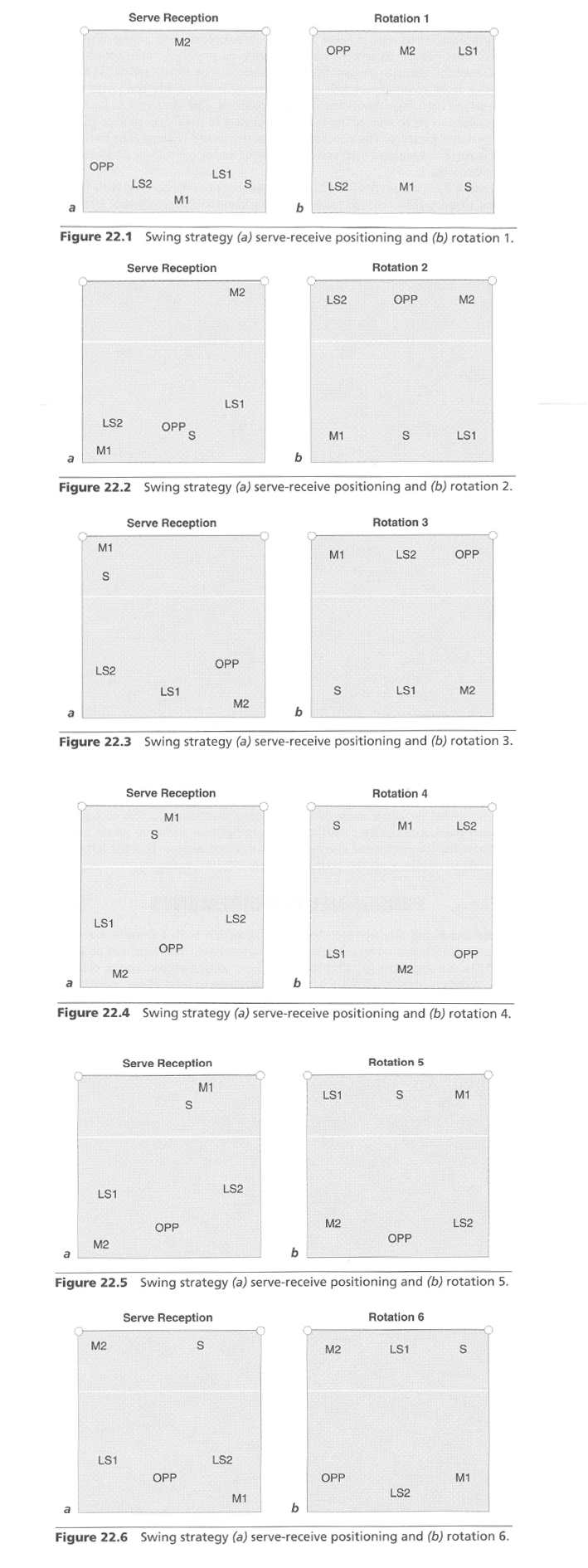|
By: USA Volleyball Originally Published in: Volleyball Systems and Strategies Provided by: Human Kinetics
EXPLANATION OF TACTIC Teams use the swing strategy when they want particular players (usually left-side hitters) to receive serve from all six rotations. The swing allows a team's best passers to receive serve as much as possible, including when they're in the three front-row hitting positions. The term "swing" is used because front-row players will generally pass from inside the court and then swing into their front-row hitting positions. The strategy can be used in any kind of serve-receive but is most common in the three- or four-player serve-receive patterns. The simplest form of the swing strategy is to have the hitters receive serve and then quickly move to attack from their usual front- row positions. Figures 22.1 through 22.6 show a three-player serve-receive with both left-side hitters (LS1 and LS2) as passers in addition to the right-side attacker (OPP) in a 5-1 (one-setter) offense. Refer back to figure 15.1 (p. 138) to see how players are arranged in the rotation in a 5-1 system. In addition, review the material in chapter 15 (Options section) about the overlap rule involving adjacent players. As a reminder, here's a list of players and their adjacent:
Understanding the overlap rule is necessary as your team manipulates serve-receive patterns within the swing offense. In figures 22.1 through 22.6 you can see how the swing element is incorporated. Notice for example in figure 22.1 that the best left-side hitter (LS1) is right front, and the opposite (OPP) is left front. Once the opposing team serves, both of these players swing out to their hitting areas. Simply, the opposite player swings outside to hit a left-side attack, and the left-side attacker swings to the right side to hit a right-side attack; then they make their switch to their normal front-row position once the ball enters the opponent's court. This is but one possible option. Figures 22.2 and 22.5 illustrate how the swing strategy is most often executed. Note in these rotations that the left sides (LS1 and LS2) are passing from the left-back position (LS1 in figure 22.5 and LS2 in figure 22.2). Once they pass, they will very likely swing outside to gain an effective approach angle (assuming they're right-handed attackers). The primary reason teams choose to use the swing is to allow their best passers to receive serve most often, requiring front-row players to handle primary passing duties and then transition to become attackers. As we move to discussing the personnel needed for this strategy, assume that the left-side passers and opposite are the primary passers in this system. PERSONNEL REQUIREMENTS To use the swing strategy just described, in which both left sides and the opposite are the primary passers, your team must have three excellent passers. (Refer to the appendix [p. 235] to review how to rate players in the skill of serve-receive.) Ideally, all three of these passers are at least above a 2.0 aver-age, and preferably at or above 2.5. Because left-side attackers are typically two of the team's best hitters, these players must be able to handle the stress of passing in a three-player serve-receive while being counted on to provide outstanding hitting as well. When opposing teams see that a primary hitter in a team's offense (usually a left-side hitter) is also a primary passer, the servers will serve them a lot of balls, hoping to wear them down physically. This passer must have physical (conditioning), technical (passing technique), and tactical (passing and hitting) skills to respond well to the opponent's tactics. Having said this, it's helpful if these primary passers and key hitters are strong athletes with good jumping abilities. Stronger, quicker, and more explosive athletes will be better equipped to handle the demands of this strategy. Regardless of the system your team is playing, it's important to have a setter who can set consistent and hittable balls, but this is even more true in the swing strategy. Because greater demands are placed on the players who pass in all six rotations, having consistent sets allows the primary passers/hitters to play at a high level because they know they'll receive a consistently hittable ball. Late in a long match when these primary passers/hitters are getting inconsistent sets, greater stress is placed on them than when they're getting consistently hittable balls each time. Setters must work toward being consistent in their delivery of all sets but perhaps especially when setting to those players who have both hitting and passing responsibilities because in a long match these players will likely become fatigued. ADVANTAGES AND DISADVANTAGES One of the main advantages of the swing is that a team's best passers can receive serve in all six rotations, which allows the serve-receive offense to run efficiently. Even great serving teams will have difficulty disadvantaging their opponent when passers are performing at a high level. The swing offense also allows hitters greater opportunities to hit many types of sets along the net out of serve-receive, which can confuse the defense. This advantage becomes more prominent as hitters develop a greater range of skills and a bigger repertoire of sets. Because front-row passers are passing from back-row positions, the swing strategy can confuse the blockers as to who the front-row hitters are. This gives the offense an advantage because the blockers might be watching the wrong players to get their reads on sets and attacks. A disadvantage arises when a team is unable to pass well on a given night. Not only does the pass limit what the setter can do, but the front-row players who are primary passers are more likely to be out of position to hit any kind of ball because they are often positioned in the back row to receive serve in the first place. This results in the team providing the opponent a free ball, giving attack advantage back to them. Of course an injured player is a disadvantage in any system or strategy, but a swing offense might have more trouble adapting to injury than others. Because three of a team's hitters carry a heavy passing and hitting load, keeping these three players healthy is particularly important. If one of these players gets hurt, it's very rare for the sub to come in and perform at the same level. An injury also poses problems on serve-receive because a new player communicates differently from the injured player as part of the serve-receive, resulting in a possible miscommunication among passers. Another disadvantage involves an opponent who can consistently serve the ball into the last 5 feet (1.5 meters) of the court into all three back-row positions. Teams that can force passers to move backward, especially front-row players, reduce the chances of hitters getting aggressive swings. If a left-front player is passing from the left-back position (figure 22.2) and has to receive serve deep in the corner where M1 is standing, the left front will have difficulty on two fronts. First, he or she may have trouble passing the ball well. Second, even if the pass is perfect, the transition for the left-side player is a significantly longer distance compared to when the ball is served into the middle of the court. OPTIONS If you have three great passers, but two are middle blockers and one is a left- side player, it's possible to use the swing strategy with these players as well. Designing serve-receive for two, three, or four passers is encouraged, assuming your team is placing its best passers in the zones that allow them to receive the most serves (while not violating the overlap rule). As mentioned in the previous section, teams must be ready to adjust to the opponent that can serve consistently to the deep corners. Figure 22.7 illustrates one such adjustment used when an opponent is serving deep crosscourt to the left-side hitter (LS2). In this modified serve-receive pattern, the M1 moves into the serve-receive pattern, allowing the LS2 to move forward. The LS2 now only has responsibility to pass the short crosscourt serve and can focus more on hitting. Of course this adjustment would occur only if the middle hitter has adequate serve-receive skills and you have trained this adjustment in practice. If a front-row hitter can't get to his or her designated hitting spot, the swing hitters should hit a set from another spot along the net until they are better able to transition to their designated position. Alternatively, some teams employ a strategy in which swing hitters can hit anywhere along various zones of the net, based in large part on their overall attacking capabilities and what opposing blockers are doing to stop them. It's also possible to incorporate the swing offense with the left-side hitters passing in any one of the passing positions.
COACHING POINTS A coach will probably know who the team's best passers are, but if there's any doubt, keep statistics (in both games and practices) for every player who passes. You want to be sure to have your three best passers receiving serve as often as possible in this strategy. In practice, allow plenty of competitive opportunities for primary passers to pass and then transition to hit against well-formed blocks. Depending on who's passing and from where, it might be difficult to run many fast-tempo sets, as described earlier. Consider overloading your primary passers and hitters during practice, forcing them to learn how to be productive against a much bigger block than they'll see in matches. Even consider designing drills in which these players are required to pass and terminate a number of balls against three blockers. If they can have success with this in practice, you know they'll excel against one- and two-player blocks in real games. Finally, don't underestimate the roles of the nonpassers in the success of a serve-receive. In figures 22.1 through 22.6, you might have noticed that certain players are placed in the corners (to avoid overlap) as part of the serve-receive pattern. It might seem that these players have no useful purpose, but that's not so. Players without passing responsibility should be communicating to teammates before the ball is served, offering suggestions to the passers on what kind of serve is coming and to what spot. Then, after the ball has been contacted by the server, these players call out where the ball is going and whether it's in or out. Be sure to involve your team's nonprimary passers in all serve-receive plays so they have the chance to play the critical roles available to them.
|









